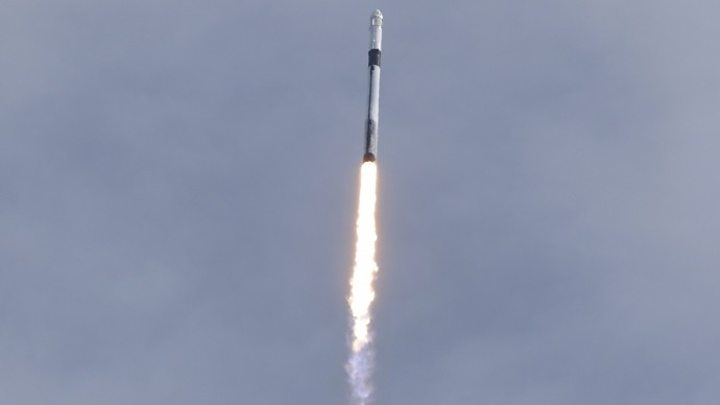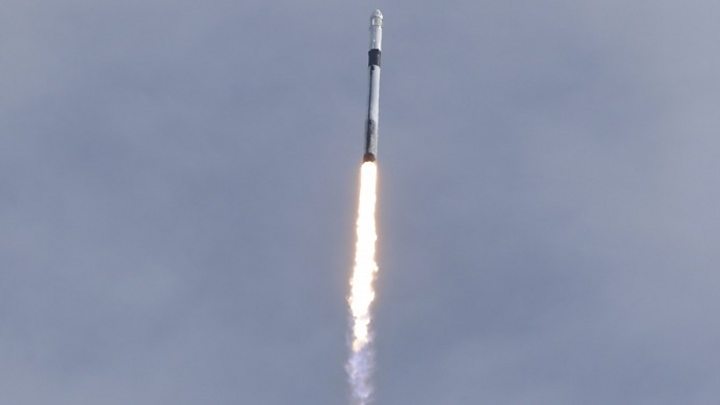SpaceX completes emergency crew escape manoeuvre
The US company demonstrates how it would rescue astronauts during a failing rocket launch. …


Media playback is unsupported on your device
SpaceX has conducted a test of the abort manoeuvre it would use if one of its crew-carrying rockets ever developed a problem during flight.
The rehearsal at Kennedy Space Center saw a Falcon-9 vehicle’s ascent into the sky deliberately terminated just 80 seconds after lift-off.
The Dragon astronaut capsule on top fired its escape engines to carry itself clear of the “faulty” booster.
Parachutes brought the vessel to a safe splashdown some 30km off Florida.
No humans were involved in the practice abort; the only occupants of the Dragon ship were a couple of Anthropomorphic Test Devices, or “dummies”.
This was considered to be the last major milestone for California’s SpaceX company before the US space agency (Nasa) certifies the firm to carry astronauts to the International Space Station (ISS) later this year.
Nasa has contracted both SpaceX and the aerospace giant Boeing to take over routine transportation of astronauts to low-Earth orbit.
Not since the retirement of the space shuttles in 2011 have American crews been able to launch from American soil.
The apparently flawless in-flight abort demonstrated on Sunday should bring this long hiatus to close, perhaps by early summer.
SpaceX had promised the escape manoeuvre would be spectacular, and so it proved.
As the Dragon capsule fired its escape engines, the Falcon booster underneath lost aerodynamic stability, broke apart and exploded in a huge ball of flame.
But by then, the crew capsule was well away, continuing to climb skyward thanks to its powerful superDraco thrusters.
Onboard video showed the Dragon drop its service-module segment, or “trunk”, before releasing two drogue parachutes.
Four main chutes then emerged.
These 35m-wide envelopes lowered Dragon into the waters of the Atlantic Ocean a little over nine minutes after the Falcon’s lift-off.
Teams from SpaceX and the US Air Force were stationed offshore to begin the recovery of the capsule and bring it back to land.
Company CEO Elon Musk lauded everyone involved in the test and marvelled at some of the day’s statistics: “The peak velocity of Dragon during abort was more than double the speed of sound, Mach 2.2, and achieved an altitude of 40km, 131,000ft. These are exciting specs, for [Dragon] to have gone to three times the altitude of a typical airliner,” he told reporters.
The importance of having an effective abort capability was underlined by the 2018 experience of Russian cosmonaut Alexey Ovchinin and Nasa flight engineer Nick Hague.
They were on a routine journey to the ISS when their Soyuz rocket damaged itself two minutes into the ascent. The men only escaped death because their capsule also had an emergency system to pull the vessel to safety.
It will be recalled also that the Challenger space shuttle in 1986 had no such escape capability and all seven crew members died when the orbiter began to break up 72 seconds into its mission.
Nick Hague tweeted after watching Sunday’s demonstration: “Trust me… surviving a rocket failure by way of a successful abort system made today’s test personal. Thank you @SpaceX & @usairforce Guardian Angels!”
Both SpaceX and Boeing were supposed to make their “astronaut taxi services” available in 2017, but the companies have had to grapple with – and overcome – some tricky technical challenges.
SpaceX, for example, saw one of its capsules explode on a testbed in April last year. And Boeing, which calls its crew capsule Starliner, hit trouble on an uncrewed dummy run to the space station last month.
The Starliner experienced an anomaly immediately after launch that led it to waste fuel reserves, leaving it short of the propellant necessary to reach the orbiting outpost.
All that said, it seems likely both SpaceX and Boeing will get to debut crewed flights in the coming months.
Nasa has selected shuttle veterans Doug Hurley and Bob Behnken to make the first Dragon crewed flight. Mr Musk said their capsule would be at Kennedy shortly and could be ready to fly before July.
But Nasa Administrator Jim Bridenstine said the “go for launch” for Hurley and Behnken might depend on how long the agency wanted the men to stay on the space station.
“Do we want that first crew to be a short duration (mission)? Or do we want it to be a longer duration? If it’s going to be a longer duration, then we have to have some additional training for our astronauts to actually be prepared to do things on the International Space Station that we weren’t planning to have that initial test crew necessarily do.”
Jonathan.Amos-INTERNET@bbc.co.uk and follow me on Twitter: @BBCAmos



